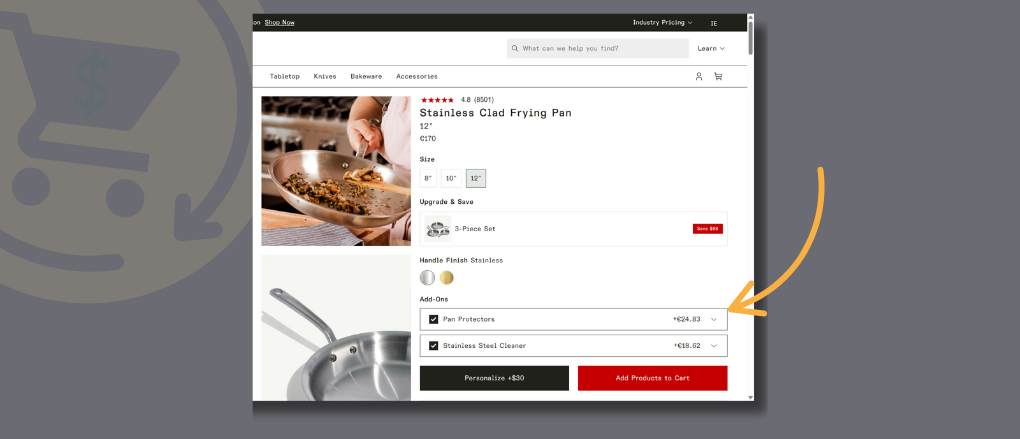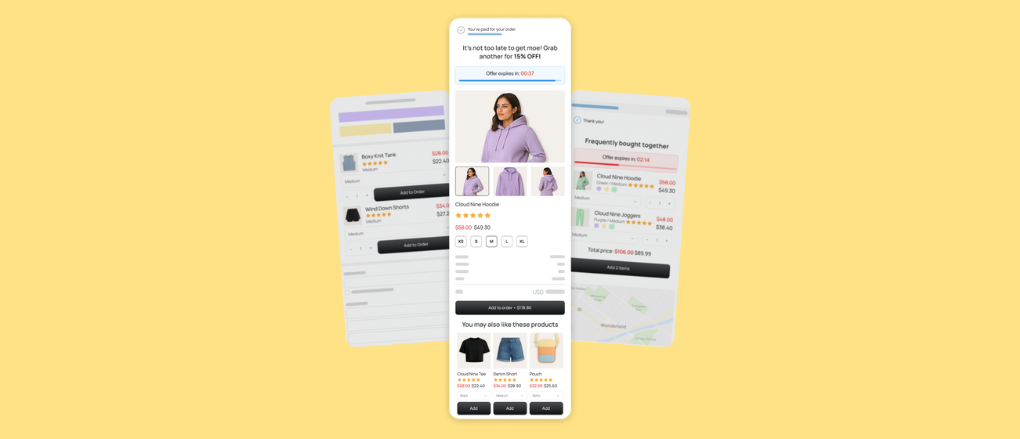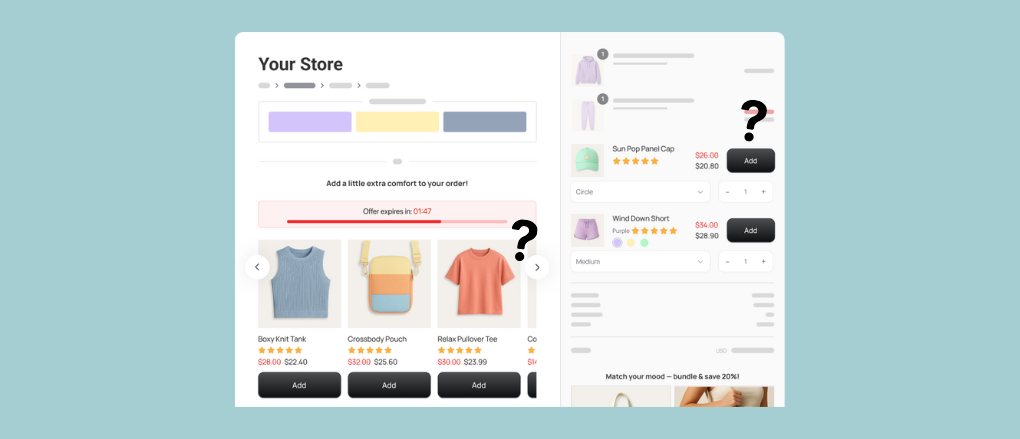6 of the Best Cross-Selling Strategies We’ve Seen (With Examples)
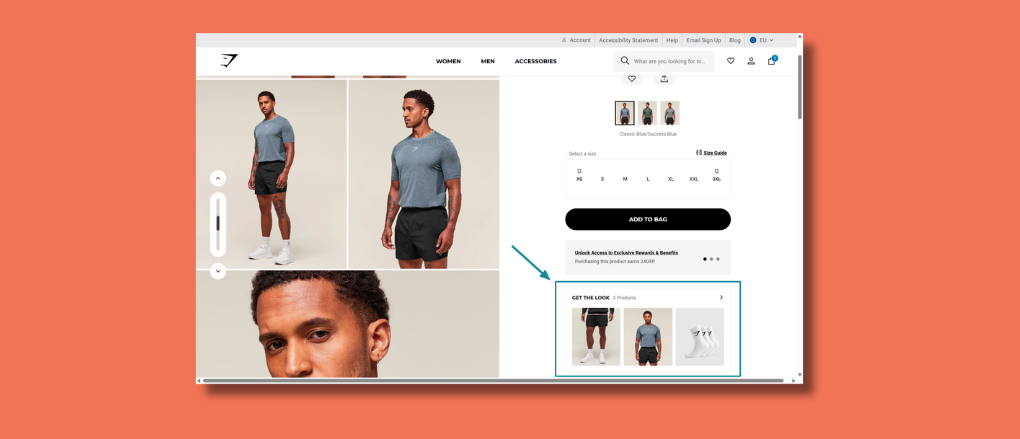
Cross-selling strategies are the unsung hero of eCommerce growth.
It’s not about pushing random products; it’s about showing the right add-on at the right time. Think laptop + case, coffee machine + pods, or sneakers + socks. Simple, relevant, and instantly more profitable.
The best part? You don’t need to be Amazon to pull this off. With the right cross-selling strategies in your Shopify store, you can boost AOV, delight customers, and make every order count.
In this post, we’ll break down the most effective cross-selling strategies we’ve seen (with real-world examples) and the principles that make them work.
Let’s get started.
The Best Cross-Selling Strategies We’ve Seen
If you’ve ever wondered how to improve cross-selling in your Shopify store, the answer is simple: focus on tactics that are easy to implement and proven to lift AOV.
Let’s break down the best ones we’ve seen in the wild. Short, sharp, and ready to copy.
1. Add Low-ticket Cross-Sells at Checkout
The most famous checkout cross-sell of all time? “Would you like fries with that?” McDonald’s turned a simple add-on into billions in extra revenue.
For Shopify stores, the same principle applies. Checkout is a golden moment to suggest low-ticket add-ons that feel natural. Here’s an example from ReConvert user OddBalls:
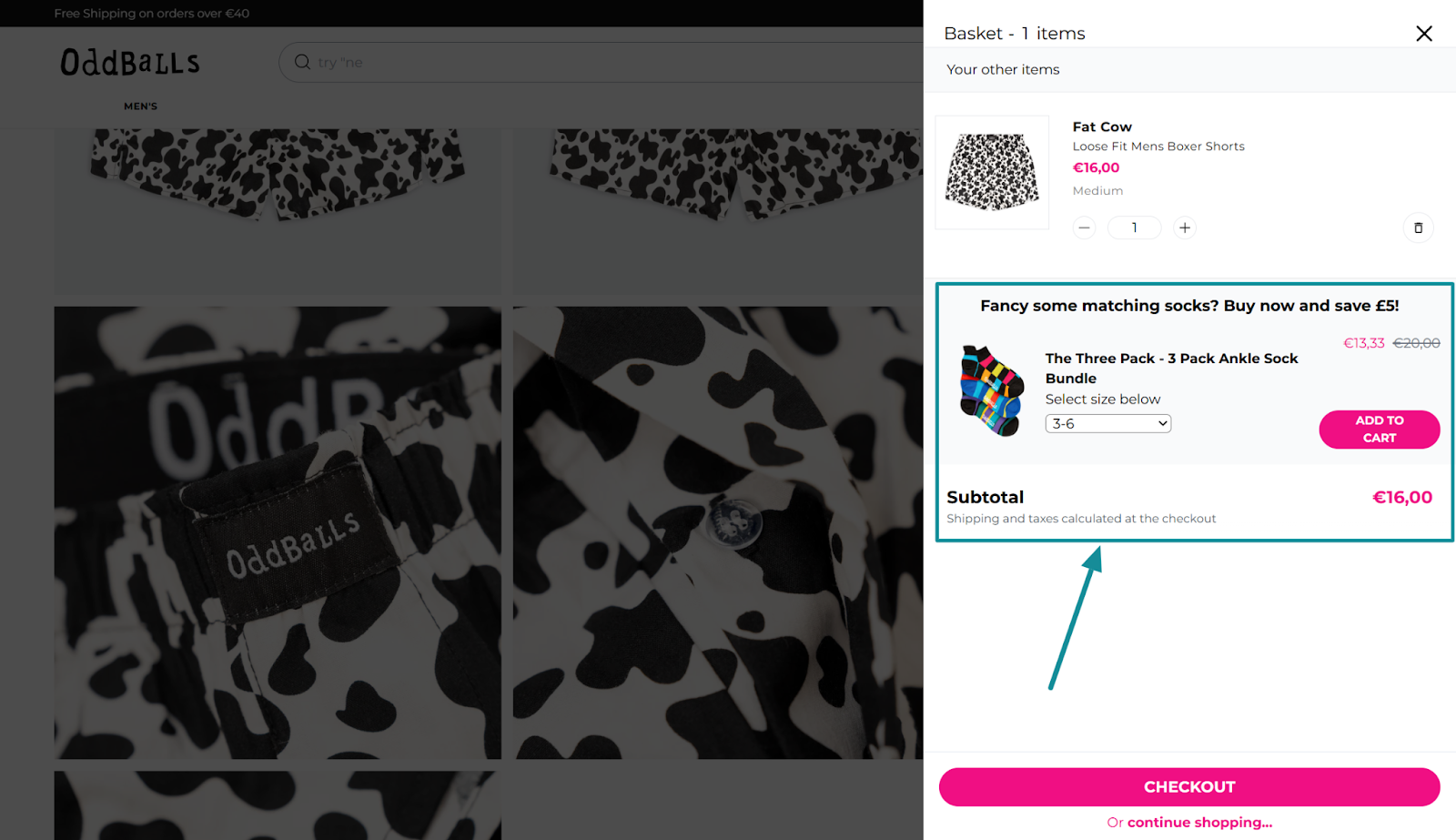
We’ve also seen many ReConvert users get strong results offering shipping insurance at checkout, since it’s low-cost, easy to understand, and directly connected to the purchase.
The key is relevance. Customers won’t bite on random suggestions, but they will happily say yes to products that protect, improve, or complete their order.
A case for a phone. Pods for a coffee machine. Insurance for shipping.
Want to know how to improve cross-selling at checkout? Keep the focus on value, not price. “Protect your new phone and save 15% today” converts far better than “Add a case for $20.”
And when you get it right, the impact is huge.
Across ReConvert stores, cross-selling has generated an average of 5.6% uplift in AOV and conversion rates as high as 28.3% on top-performing offers.
In fact, 91% of ReConvert users recommend it as one of the most effective ways to drive extra sales.
2. Follow up with one-click post-purchase upsells
One click upselling is one of the highest-converting strategies in eCommerce. The purchase is already complete, payment details are saved, and with a single click customers can add more to their order without friction.

And the results are hard to ignore. For every $1 retailers invested in post-purchase cross-selling, they generated an average of $686 in sales.
What’s more the average ReConvert one-click upsell converts at 4.7%, while top offers hit 28.3%.
The key is keeping it seamless. No extra forms, no friction. Just a simple “add this too” button. If the offer is relevant, customers don’t hesitate, because it feels like you’re doing them a favor by making the purchase complete.
The formula is simple: keep the offer relevant, compelling, and low-friction. Add subtle scarcity in the form of a countdown timer for even more conversions. Add-ons that protect, upgrade, or replenish the original purchase are the ones that win.
3. Bundle products into kits
Bundles are one of the oldest cross-selling strategies in retail, and for good reason.
They package complementary products together, making it easy for shoppers to say yes to more.
Think skincare kits, coffee + filters + mugs, or “starter packs” that cover all the essentials in one click.

The psychology is simple: customers love convenience and value.
A well-designed bundle removes the decision fatigue of having to choose add-ons separately.
Instead of debating whether they need one more product, they see a ready-made solution that feels like a better deal.
The best bundles highlight benefits, not just discounts. “Everything you need for a flawless morning routine” is more compelling than “Save 10 percent when you buy three.”
Position the offer around time saved, problem solved, or lifestyle improved.
Another tip: use your data. Look at items frequently purchased together and build bundles around them.
The more natural the pairing, the higher the conversion rate. Seasonal or event-driven bundles - like Back-to-School or Holiday Gift Sets - can also give sales a serious lift.
With ReConvert, you can set up dynamic bundles right on your product page, your cart drawer, checkout flow, and post-purchase pages.
That way, every shopper sees offers tailored to what’s in their cart, increasing order value without adding friction.
4. Suggest relevant add-ons on your order confirmation pages
Most brands let their thank you page sit idle. Big mistake. Customers actually revisit it more than twice per order, which makes it a prime spot for cross-selling.
The thank you page works best when the offer feels exclusive to that transaction. With ReConvert, you can display limited-time deals right on the page, complete with countdown timers.

The mockup above shows it perfectly: “Offer expires in 01:47.” That urgency encourages quick action without being pushy.
Personalization makes it even stronger. You can recommend items that complement the exact products just purchased, or surface popular add-ons that align with the customer’s cart. New buyers might see discovery items, while loyal shoppers could get VIP bundles or early access deals.
“Thank you page cross selling provides incredible value - many merchants don't realize how many times their customers see their thank you page. The impressions are crazy - two, three, even up to four times per order is standard. When you think about it, that’s more impressions than any other part of the funnel - so optimization is non-negotiable”
Jacob Elbaum, CEO of Shivook, eCommerce CRO agency
The results add up. Thank you page cross-sells convert at an average of 1.7%. That may sound small, but when every single order passes through this page, it quickly compounds into meaningful revenue.
5. Cross-sell related products in your order confirmation emails
Just because the order is complete doesn’t mean the cross-sell opportunity is gone. Email is a powerful way to follow up and suggest products that make the original purchase even better.
Timing is everything. Too soon, and it feels pushy. Too late, and the spark is gone. The sweet spot depends on your product. If someone buys a coffee machine, send an email a few days later with best-selling pods. If it’s skincare, follow up in a few weeks with a refill bundle.
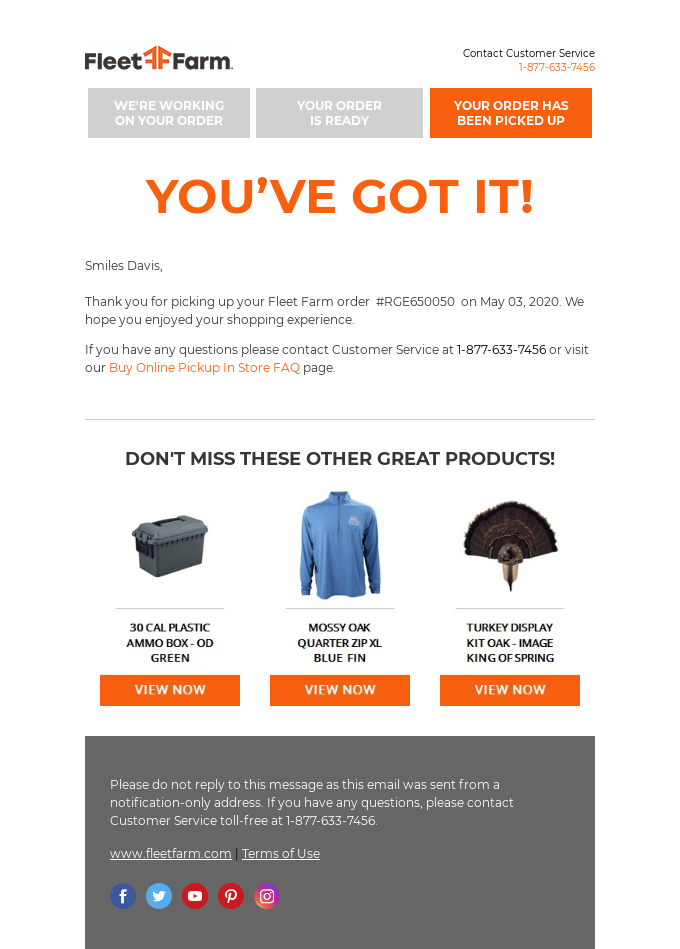
A great example of this comes from Fleet Farm. After an order is picked up, they send an email confirming the purchase but also highlight three related products with strong visuals and clear CTAs (“View Now”). This kind of follow-up feels natural and helpful, not intrusive.
The magic lies in relevance. Use customer data to recommend products that complete the original order, or surface your most popular add-ons.
Email gives you more space than a checkout page or cart drawer, so you can layer in reviews, product descriptions, or even a short how-to video.
6. Use customers ’ birthdays to cross-sell relevant products
Loyal customers are your best customers. They already trust your brand, so the right cross-sell offer feels less like a sales pitch and more like a perk. The key is making them feel valued and special.
One of the smartest ways to do this is through personalization tied to milestones.
With ReConvert’s relaunched birthday collector, you can capture customer birthdays at checkout or on the thank-you page, then use that data to surprise them with a special gift or exclusive offer.

Imagine this: a customer buys a skincare kit in March. On their birthday in June, they get an email that says, “Happy Birthday! Enjoy 30% off your favorite serum, just for you.” Not only does this feel personal, it also drives them back to buy something connected to their last purchase.
This type of cross-sell works because it combines two powerful principles: timing and relevance.
The offer lands on a day when customers are most open to treating themselves, and it ties directly to a product they already know and like.
The result? Stronger loyalty, repeat purchases, and higher lifetime value. ReConvert makes it easy to set this up, so every birthday becomes both a celebration and a sales opportunity.
Cross-Selling Strategies Best Practices

Strategies get you started, but best practices are what make them work at scale. The difference between a cross-sell that converts and one that falls flat often comes down to execution.
- Timing matters most. The right offer at the right moment feels natural, while the wrong timing feels pushy. Checkout, post-purchase, thank you pages, and follow-up emails each have their own sweet spot. Test where your customers respond best.
- Keep it relevant. Shoppers only want to see products that genuinely connect to what they just bought. A coffee machine buyer needs pods, not an unrelated blender. Use purchase history, browsing data, or customer segments to keep recommendations on point.
- Don’t overwhelm. More options don’t equal more conversions. One or two highly targeted offers outperform a carousel of ten random suggestions. Focus on clarity, not clutter.
- Frame the value. Instead of just showing the price, explain how the add-on improves or protects the main purchase. This helps the offer feel like a benefit, not an upsell tactic.
- Always test. Even small tweaks, such as changing the product image, headline, or placement, can significantly impact conversion rates. A/B testing your cross-sells ensures you’re not leaving easy wins on the table.
When you combine timing, relevance, simplicity, and testing, cross-selling stops feeling like selling. It becomes part of a seamless customer experience that lifts both AOV and satisfaction.
Define Your Cross-Selling Strategies Today!
Cross-selling isn’t just a tactic, it’s one of the most reliable growth levers for Shopify stores. By applying the right cross-selling tips, you can increase average order value, improve customer experience, and build long-term loyalty without spending more on ads.
Here’s what to remember:
- Checkout, thank you pages, and post-purchase flows are the highest-impact places to add cross-sells.
- Personalization and relevance are what separate great offers from annoying ones.
- Keep it simple: one or two clear product suggestions will always outperform a wall of options.
- Urgency, exclusivity, and loyalty rewards are powerful ways to boost conversions.
- Test, optimize, and refine - this is how to improve cross-selling over time.
With ReConvert, you don’t just get tools for one strategy. You get a full platform built to handle cart drawer offers, one-click post-purchase cross-sells, thank you page widgets, birthday collectors, and more. That means you can apply every best practice and see results fast.
Get started with ReConvert today and turn every order into an opportunity to increase AOV, delight customers, and grow your store profitably.
Cross-Selling Strategies FAQ
Let’s quickly answer some of the most common questions relating to cross-selling strategies.
What is a cross-selling strategy?
A cross-selling strategy is a way of recommending complementary products alongside a customer’s main purchase. For example, suggesting a phone case when someone buys a phone. These offers increase average order value while improving the shopping experience.
How do I improve cross-selling in my Shopify store?
The best way to improve cross-selling is to focus on relevance and timing. Use customer data to recommend products that match the original purchase, and test different placements like checkout, thank you pages, and post-purchase flows. Small A/B tests on copy, images, or discounts can quickly boost results.
What are some effective cross-selling examples?
Classic cross-selling examples include bundling skincare products into a starter kit, offering coffee pods with a coffee machine, or suggesting pet treats when someone buys dog food. Online, cart drawer recommendations and one-click post-purchase offers are among the highest-converting approaches.
How many cross-sell offers should I show?
Keep it simple. One or two highly targeted cross-sell offers work best. Too many options can overwhelm shoppers and reduce conversions. Focus on clarity and value, not volume.
Do cross-selling strategies annoy customers?
Not if they’re relevant. Customers appreciate suggestions that save them time or make their purchase more complete. A good cross-selling strategy feels like helpful guidance, not a pushy upsell.





